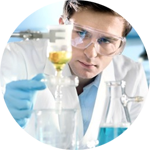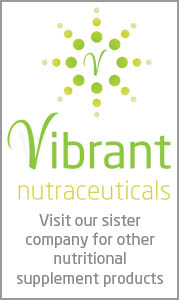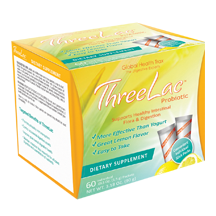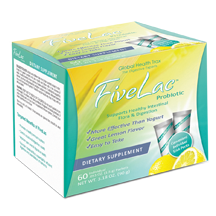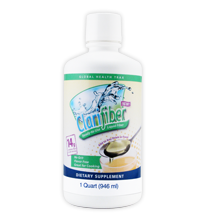Yeast Overgrowth Symptoms and Treatment
What is yeast overgrowth and why is it such a hot topic lately?
Can I treat my yeast overgrowth by changing my diet?
Why should I use ThreeLac to help with my yeast overgrowth when I could just eat yogurt?
What are Probiotics?
Why has there been so much press about Probiotics in the last few years?
How do I know if I need Probiotics?
How do Probiotics work?
How do I balance my "good" and "bad" bacteria?
What are the some of the best-selling (most popular) Probiotic products on the market?
I hear a lot about a high-fiber diet but why is it really important?
What's the best way to get more fiber in my diet?
Besides whole grains and fruit, how else can I get more fiber into my diet?
How does adding more fiber to my diet help with probiotics?
Yeast Overgrowth Symptoms and Treatment
What is yeast overgrowth and why is it such a hot topic lately?
There are types of yeast that live in all of us. The amount in your body is kept in proper balance when your immune system is working efficiently. As our population takes more antibiotics and consumes unhealthy amounts of sugars and carbohydrates, the yeast in our bodies can grow out of control. Some of the symptoms that indicate you may have a yeast overgrowth are:
- Anger outbursts
- Irritability
- Headaches
- Constant tiredness and exhaustion
- Anxiety
- Mood swings
- Obsessive compulsive disorder (OCD)
- Intense cravings for sugars, sweets, and breads
- Itchy skin
- Frequent stomach pains and digestion problems
- Skin problems (skin infections, eczema, psoriasis, acne)
- Foggy brain / Trouble concentrating
Can I treat my yeast overgrowth by changing my diet?
You can adjust the amount of yeast in your body through diet however it is not as easy as many people may think. You would have to significantly reduce and even completely cut out sugar and high-carb foods. Although most people can do this, they can't sustain it for long and depriving themselves of these foods can often result in binge eating behavior which is counterproductive. The more sugar you intake the more fuel you give yeast to grow in your body.
One of the best natural options for reducing yeast is ThreeLac. Because ThreeLac may help reduce the symptoms of yeast overgrowth it is an easier method than adhering to a very strict diet regimen.
Why should I use ThreeLac to help with my yeast overgrowth when I could just eat yogurt?
One of the benefits to using ThreeLac is that it may alleviate the yeast overgrowth symptoms faster than other treatment methods. For those people who have lactose intolerant issues, yogurt is not always an option and ThreeLac may be an option.
The Latest News on Probiotics
What are Probiotics?
Probiotics are live microorganisms (in most cases, bacteria) that are similar to beneficial microorganisms found in the human gut. They are also called "friendly bacteria" or "good bacteria." Probiotics are available to consumers mainly in the form of dietary supplements and foods.
Experts have debated how to define probiotics. One widely used definition, developed by the World Health Organization and the Food and Agriculture Organization of the United Nations, is that probiotics are "live microorganisms, which, when administered in adequate amounts, confer a health benefit on the host." (Microorganisms are tiny living organisms - such as bacteria, viruses, and yeasts - that can be seen only under a microscope.)
Probiotics are not the same thing as prebiotics - nondigestible food ingredients that selectively stimulate the growth and/or activity of beneficial microorganisms already in people's colons.
Probiotics are available in foods and dietary supplements such as GHT's ThreeLac and FiveLac products. Examples of foods containing probiotics are yogurt, fermented and unfermented milk, miso, tempeh, and some juices and soy beverages. In probiotic foods and supplements, the bacteria may have been present originally or added during preparation.
Why has there been so much press about Probiotics in the last few years?
With the increase in the number of medications, specifically antibiotics, the amount of friendly bacteria and unfriendly bacteria in the body has been thrown off balance. The medical community is seeing more and more symptoms of this imbalance in the forms of:
- Infectious diarrhea
- Irritable bowel syndrome
- Inflammatory bowel disease (e.g., ulcerative colitis and Crohn's disease)
- Infection with Helicobacter pylori (H. pylori), a bacterium that causes most ulcers and many types of chronic stomach inflammation
- Tooth decay and periodontal disease
- Vaginal infections
- Stomach and respiratory infections that children acquire in daycare
- Skin infections
How do I know if I need probiotics?
There are several reasons that people are interested in probiotics for health purposes. Have you taken our Home Test yet?
First, the world is full of microorganisms (including bacteria), and so are people's bodies - in and on the skin, in the gut, and in other orifices. Friendly bacteria are vital to proper development of the immune system, to protect against microorganisms that could cause disease, and to the digestion and absorption of food and nutrients. Each person's mix of bacteria varies. Interactions between a person and the microorganisms in his/her body, and among the microorganisms themselves, can be crucial to the person's health and well - being.
This bacterial "balancing act" can be thrown off in two major ways:
1. By antibiotics, as they kill friendly bacteria in the gut along with unfriendly bacteria. Some people use probiotics to try to offset side effects from antibiotics like gas, cramping, or diarrhea. Similarly, some use them to ease symptoms of lactose intolerance - a condition in which the gut lacks the enzyme needed to digest significant amounts of the major sugar in milk, and which also causes gastrointestinal symptoms.
2. "Unfriendly" microorganisms such as disease-causing bacteria, yeasts, fungi, and parasites can also upset the balance. Researchers are exploring whether probiotics could halt these unfriendly agents in the first place and/or suppress their growth and activity in conditions like:
- Infectious diarrhea
- Irritable bowel syndrome
- Inflammatory bowel disease (e.g., ulcerative colitis and Crohn's disease)
- Infection with Helicobacter pylori (H. pylori), a bacterium that causes most ulcers and many types of chronic stomach inflammation
- Tooth decay and periodontal disease
- Vaginal infections
- Stomach and respiratory infections that children acquire in daycare
- Skin infections
Another part of the interest in probiotics stems from the fact there are cells in the digestive tract connected with the immune system. One theory is that if you alter the microorganisms in a person's intestinal tract (as by introducing probiotic bacteria), you can affect the immune system's defenses.
How do Probiotics Work?
The average human body is home to about three pounds of living bacteria. Over four hundred species, numbering over one hundred trillion individual bacteria live in the gut alone. We live in symbiosis with these bacteria by giving them a safe, warm, and wet place to live. These bacteria, in turn, fight invading microorganisms, break up fats, destroy cholesterol, alleviate food allergies, dissolve cancer-causing agents, remove blood toxins, and even produce essential vitamins.
The bacteria survive mostly in our intestines, lungs, and on our skin, eating the things that are harmful to us. When we are invaded by disease-causing bacteria or fungi, the probiotic bacteria eliminate the pathogens by what is called competitive exclusion. This term means that friendly bacteria grow to cover all available area in our bodies so any invaders cannot find enough food or space to grow.
Another way that probiotic bacteria protect against invasion is by producing acids that interfere with the growth and development of many germs such as Salmonella and the fungus, Candida.
How do I balance my "good" and "bad" bacteria?
Probiotics are live microorganisms (in most cases, bacteria) that are similar to beneficial microorganisms found in the human gut. They are also called "friendly bacteria" or "good bacteria." Probiotics are available to consumers mainly in the form of dietary supplements and foods.
Probiotics are available in foods and dietary supplements such as Global Health Trax, Inc.'s ThreeLac and FiveLac products. Examples of foods containing probiotics are yogurt, fermented and unfermented milk, miso, tempeh, and some juices and soy beverages. In probiotic foods and supplements, the bacteria may have been present originally or added during preparation.
What are the some of the best-selling (most popular) Probiotic products on the market?
The Facts About Fiber
I hear a lot about a high-fiber diet but why is it really important?
Dietary fiber is the part of the plant that your body can't digest. Yet it is an important part of a healthy diet.
A high-fiber diet has many benefits, which include:
- Normalizes bowel movements. Dietary fiber increases the weight and size of your stool and softens it. A bulky stool is easier to pass, decreasing your chance of constipation. If you have loose, watery stools, fiber may also help to solidify the stool because it absorbs water and adds bulk to stool. For some, fiber may provide relief from irritable bowel syndrome.
- Helps maintain bowel integrity and health. A high-fiber diet may lower your risk of developing hemorrhoids, and small pouches in your colon (diverticular disease). Some fiber is fermented in the colon. Researchers are looking at how this may play a role in preventing diseases of the colon.
- Lowers blood cholesterol levels. Soluble fiber found in beans, oats, flaxseed and oat bran may help lower total blood cholesterol levels by lowering low-density lipoprotein, or "bad," cholesterol levels. Epidemiologic studies have shown that increased fiber in the diet can reduce blood pressure and inflammation, which is also protective to heart health.
- Helps control blood sugar levels. Fiber, particularly soluble fiber, can slow the absorption of sugar, which for people with diabetes can help improve blood sugar levels. A diet that includes insoluble fiber has been associated with a reduced risk of developing type 2 diabetes.
- Aids in weight loss. High-fiber foods generally require more chewing time, which gives your body time to register when you're no longer hungry, so you're less likely to overeat. Also, a high-fiber diet tends to make a meal feel larger and linger longer, so you stay full for a greater amount of time. And high-fiber diets also tend to be less "energy dense," which means they have fewer calories for the same volume of food.
What's the best way to get more fiber?
Fiber is commonly classified into two categories: those that don't dissolve in water (insoluble fiber) and those that do (soluble fiber).
Insoluble fiber.
This type of fiber promotes the movement of material through your digestive system and increases stool bulk, so it can be of benefit to those who struggle with constipation or irregular stools. Whole-wheat flour, wheat bran, nuts and many vegetables are good sources of insoluble fiber.
Soluble fiber.
This type of fiber dissolves in water to form a gel-like material. It can help lower blood cholesterol and glucose levels. Soluble fiber is found in oats, peas, beans, apples, citrus fruits, carrots, barley and psyllium.
Besides whole grains and fruit, how else can I get more fiber into my diet?
How does adding more fiber to my diet help with probiotics?
Some fiber supplement products can prove beneficial to probiotics (the "good bacteria" in the intestinal tract) because they:
- Effectively promote the growth of a variety of beneficial bacteria (naturally occurring or ingested as probiotics) in the colon.
- Are designed for slow fermentation. The digestion resistant maltodextrin is fermented slowly, producing less acid and gas than most soluble dietary fibers, thus avoiding undesirable side effects.
- Have secondary and tertiary nutritional benefits from fermentation byproducts such as short chain fatty acids can add to maintaining good intestinal and overall health.
